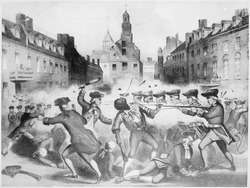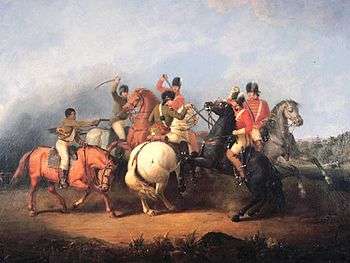Black Patriot
| Black Patriot | |
|---|---|
|
This depiction of the 1781 Battle of Cowpens, showed an unnamed, Patriot, black soldier, possibly a slave, on (left), firing his pistol and saving the life of Colonel William Washington, a second cousin, of General George Washington, on a white horse, in the center, from an 1845 painting, by artist, William Ranney | |
| Active | 1775-1783 |
| Country |
|
| Allegiance |
|
| Branch | Continental Army, Patriot militias, associators |
| Type | infantry, dragoons, (mounted infantry) |
| Size | companies to regiments |
| Engagements | American Revolutionary War |
| Commanders | |
| Notable commanders | white, [[Continental Army], military officers, white, Patriot militia, military officers, white, Patriot [associator]], military officers |
A Black Patriot was an African American, who sided with the Revolutionary Americans, during the American Revolutionary War. Black Patriots were the opposite of the group of Black Loyalists, African Americans who took up the British offer of freedom and took refuge behind the Redcoat ranks. Black Patriots includes but is not limited to the 5000 African Americans or more who fought on the Continental Army during the war.[1]
First Patriot martyr
Crispus Attucks is considered to be the first Black Patriot for his death in The Boston Massacre. Attucks was commemorated by his fellow Bostonians as a Martyr for freedom. He was a man of mixed Native American and African ancestry and was a fugitive slave after his escape in 1750 from an farm in Framingham, Massachusetts.[2] His death in the Boston Massacre is considered the first in The American Revolutionary War.[3]


%2C_by_Jean-Baptiste-Antoine_DeVerger.png)
Blacks Patriots who served in the State Militias
The Bucks of America were an all Black, Massachusetts Militia company organized, in 1775, in Boston, was the name given to one of two all-black units fighting for independence. There is little known of the campaign history, of the Bucks company, if they ever saw combat, but it appears, that they operated mainly around Boston. The Bucks of America may have acted primarily, as an auxiliary police or security service, in the city, during the war, and most likely did not see action, against British soldiers.
Blacks Patriots who served in the Continental Army
After the British started recruiting African Americans to start serving or assisting the British cause on the promise of freedom, Americans began to recruit free blacks in New England and the East Coast to serve in the army. They were promised a life of luxury and mobility if they joined the war. The northerners were also trying to escape the harsh treatment of the slavery time era. By joining the war they believed they were bettering the lives of African Americans all over.
Black Patriot soldiers served, most of the time, as individuals, in a variety of predominantly white, non-black units, of the Continental Army.
The 1st Rhode Island Regiment also, known as "Varnum's Continentals" was a Continental Army regiment from Rhode Island. It became well known as the "Black Regiment" because, for a time, it had several companies of African American soldiers. It is regarded as the first African-American military regiment, despite the fact that its ranks were not exclusively African-American.[5]
Captain David Humphreys' All Black, 2nd Company, of the Connecticut Continental Line, served from October, 1780-November, 1782. On November 27, 1780, Humphrey's Black Company was assigned to the 3rd Connecticut Regiment. On January 1, 1781, the Regiment was merged, with the 4th Connecticut Regiment, re-organized, into nine companies and re-designated, as the 1st Connecticut Regiment.
William Lee was a slave and valet who served in the Continental Army and fought with George Washington. Lee was a constant presence in Washington's life and was considered to be his favorite slave, often appearing in the background of his portraits.[6]
Descendants
Famed African American, Harvard scholar and professor Henry Louis Gates is descended from John Redman, a Free Negro who served in the Continental Army. Gates is currently working on a project to find all descendants of Black Patriots, who served in the American Revolutionary Continental Army.
Proposed memorial
The National Liberty Monument is a proposed national memorial to honor the more than 5000 enslaved and free persons of African descent who served as soldiers or sailors or provided civilian assistance during the American Revolutionary War. The memorial is an outgrowth of a failed effort to erect a Black Revolutionary War Patriots Memorial, which was authorized in 1986 but whose memorial foundation dissolved in 2005. Congress authorized the National Liberty Monument in January 2013. On September 8, 2014, the United States House of Representatives passed the joint resolution approving the location of a memorial to commemorate the more than 5,000 slaves and free Black people who fought for independence in the American Revolution.[7] The joint resolution would approve the location of a commemorative work to honor the more than 5000 slaves and free black persons who fought in the American Revolution.[8]
Notable Black Patriots
- Alexander Ames
- Crispus Attucks
- Charles Bowles
- Jeffrey Brace
- Seymour Burr
- Titus Coburn
- Grant Cooper
- Paul Cuffee
- James Armistead Lafayette
- Caesar Dickenson
- Charlestown Eaads
- James Easton
- Prince Estabrook
- Asaba Grosvenor
- Blaney Grusha
- Jude Hall
- Primus Hall
- Cuff Haynes
- Lemuel Haynes
- Henry Hill
- Cato Howe
- Agrippa Hull
- Jeremy Jonah
- Jack Little
- Barzillai Lew
- Salem Poor
- Peter Salem
- Prince Simbo
- Phillis Wheatley
- Bosson Wright
See also
References
- ↑ White, Deborah Gray (2013). Freedom on My Mind: A History of African Americans. New York: Bedford/St. Martin. p. 124-127.
- ↑ White, Deborah; Bay, Mia; Martin Jr., Waldo E. (2013). Freedom on My Mind A history of African Americans. Boston: Bedford St. Martin's. p. 124.
- ↑ White, Deborah Gray (2013). Freedom on My Mind: A History of African Americans. New York: Bedford/St.Martin. p. 149-150.
- ↑ O'Connor, The Hub, p. 56.
- ↑ "THE FIRST RHODE ISLAND". Archived from the original on 3 July 2007.
- ↑ White, Deborah Gray (2013). Freedom on My Mind: A History of African Americans. New York: Bedford/St.Martins. pp. 152–153.
- ↑ "H.J.Res. 120 - All Actions". United States Congress. Retrieved 9 September 2014.
- ↑ Marcos, Cristina (8 September 2014). "House authorizes location for American Revolution memorial in D.C.". The Hill. Retrieved 9 September 2014.
- Nell, William Cooper. The Colored Patriots of the American Revolution, With Sketches of Several Distinguished Colored Persons: To Which Is Added a Brief Survey of the Condition And Prospects of Colored Americans. Boston: Robert F. Wallcut, 1855.
